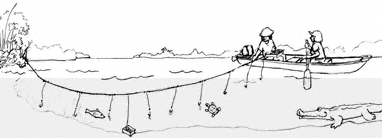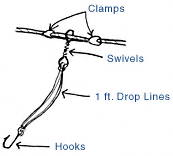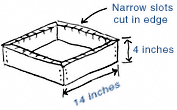|
A trot line
is a long cord with a lot of fish hooks dangling from
it. In this area you can run 25 hooks on a non-commercial
license. I have known commercial fishermen who ran
hundreds of hooks at a time, but 25 is quite enough
for me.
With a trot line
you can completely cover the width of a channel with
your hooks. Tie your line to one side of the channel,
stretch your line across and tie off to the other side
- any fish passing thru will come near one of your hooks.
You
can run your line out into a lake, too. Just tie a brick
to the end of your line to weigh it down or tie a floating
marker to it. Don't forget what tree you tied your line
to. (You could mark it with a bit of cloth or something,
but the real fishermen will laugh at you if you do.)

The
best thing about a trot line is that you don't have
to sit with it. You can put your line out in the
morning, go to work or back home, then check your line
in the evening. I used to leave my line tied up to
my favorite spot. In the mornings I would catch bait,
check the line for anything I might have caught overnight,
and rebait my hooks as I went along, leaving the rebaited
line in the water. After work I would check my lines
for the evening catch.
You
mainly catch catfish, turtles and crappie on a trot line.
Mudfish and Gar, of course, but they are no good. You
catch an occasional alligator, too, but you can't keep
him and you want to be very careful you don't get an
injury trying to pull in a line with an irritated alligator
attached. We are talking about a long string of fish
hooks here - there is a potential for injury. Trust me.
Judy
and I used to catch our bait, bait our hooks and drop
our line before heading out to explore the river for
the day. We
would pick up the line on our way back in at the end
of the day, clean our catch on the bridge and head on
home. Might be a lazy way to fish, but it suited us.
We
quit running lines a few years ago. There are too many
fish kills from agricultural runoff and it got to be
too much like work to have to clean our catch at the
end of a long hot day in the sun.
So,
here's how you make a trot line:
 You
will need to go to a fishing supply store and gather
your materials. To make a 25-hook line you will need: You
will need to go to a fishing supply store and gather
your materials. To make a 25-hook line you will need:
- 40 - 50 yards
of strong, heavy cord
- 25 swivels
- 50 clamps
- 50 feet lightweight
cord
- 25 hooks
1. Leave
10 - 15 ft of line at the end for tying off, then start
placing a clamp- swivel- clamp ...spaced a yard apart.
The clamps are to keep the swivels and drop lines spaced
apart from each other so they don't get tangled together.
If you can't find good clamps, tie knots in the main
line instead.
2. Make
25 drop lines. Take 2 foot lengths (longer if that
suits your needs) of your lighter weight line, knot
them into a loop and add a hook to each one.
3. Attach
a drop line with hook to each swivel. You may want
to do this part as you rack the line.
 
You
will also need to construct a racking box for your
line.
 1. Build
a little wooden box - roughly 14 inches square
by 4 inches deep. It doesn't have to be exact. In a
pinch you can use a cardboard box lid, but the first
time it gets wet it's ruined, so just build a box. 1. Build
a little wooden box - roughly 14 inches square
by 4 inches deep. It doesn't have to be exact. In a
pinch you can use a cardboard box lid, but the first
time it gets wet it's ruined, so just build a box.
2. About
1 inch apart cut slots into the inside top edge. The
commercial fishermen cut 25 notches per side to rack
100 hooks per box. For a 25 hook box just put 10 slots
per side. (It gives you extra, but that's ok.)
3. Now
take the main cord of your trot line and start coiling
it in the bottom of the box. Attach a drop line
with hook as you get to each swivel and slide the drop
line into a slot so that the line is gripped well but
will pull loose with ease. The hook should stick out
on the outside of the box.
 4. When
the line is coiled up and the hooks are all in place,
catch your bait and bait the hooks. Judy and I
catch grass shrimp, crawdads, grubs... anything we
are quick enough to catch and not too squeamish to
put on a hook. 4. When
the line is coiled up and the hooks are all in place,
catch your bait and bait the hooks. Judy and I
catch grass shrimp, crawdads, grubs... anything we
are quick enough to catch and not too squeamish to
put on a hook.
Now
you are ready to run your line.
1. Find
a likely spot and tie your line off to a tree on the
side. Take a moment to check that no one else is
already using that same tree a little lower in the
water - you don't want your lines to tangle together.
There have been times that Judy and I picked out a
spot only to find that someone else thought it was
a good spot, too.
If
there are fish thieves about you want to hide your line
so they won't find it and take your catch. Tie your line
low in the water and cover the visible part with grasses
so it won't be easily seen.
2. Run
your line out, weighing it down with a brick when needed. While
not impossible with one person, this job goes easier
with two. As one person paddles or runs the engine
slowly the other watches the box to make sure the line
feeds out smoothly. If coiled well the drop lines will
pull out of the slots as the line feeds into the river.
Sometimes a line will be caught a little too tightly
and you have to give it a gentle tug to help it along.
3. Come
back a few hours later to check it. Fish bite best
in early morning or just at dusk, so check as soon
after these feeding times as possible. 'Gators will
keep a close eye on trot lines, especially those left
in place for a long period, and you are liable to find
empty lines, wounded fish, or worse of all, your line
completely destroyed by a 'gator getting tangled in
it and ripping it to shreds.
Well,
actually the worse part is when the 'gator is still tangled
up and has developed a really, really bad attitude.
4. Pull
your line in, dropping it loosely into the box as you
clean off each hook. Later you can flip the box
upside down to start rewinding your line again. Don't
leave bait on the hooks and throw the box in the trunk
of your car in the Florida heat - you'll regret it.
Things
to beware of:
1. Don't
do this: My Dad used to run a line from the shore.
He would rack his line and tie a brick on the very
end. He would then throw the brick out into the lake,
and as it flew it would uncoil the line behind it.
He quit doing it this way when one day his throw was
off and he caught multiple hooks in his hand and forearm.
I do not recommend this method.
2. Check
your line with caution. When you go to check your
line pull at it gently to see if it pulls back. Always
keep in mind that if something starts pulling too vigorously
it is better to cut the line and lose it than to be
pulled screaming and full of fish hooks into the water
with something large and pissed off.
3. If
you want turtle stew... don't let Judy take the
turtle meat home, because there won't be anything left
but broth by time you show up to claim your share!
Running
a Trot Line
top
of page |


